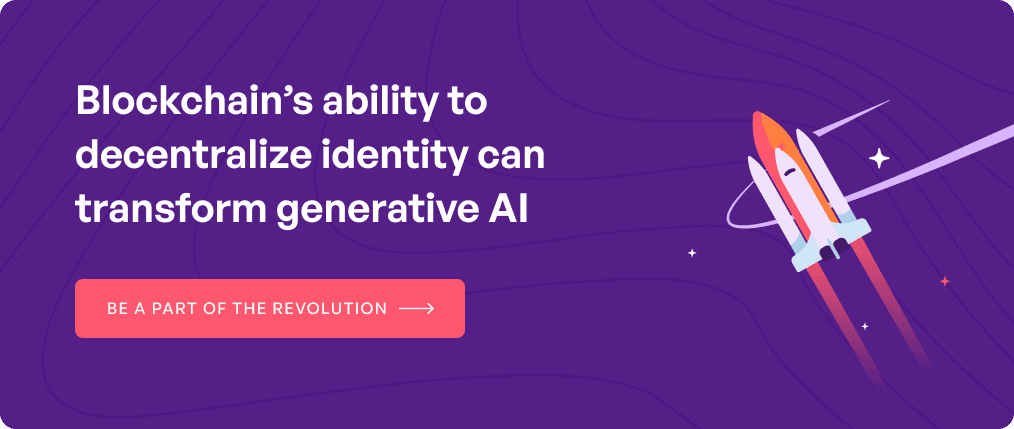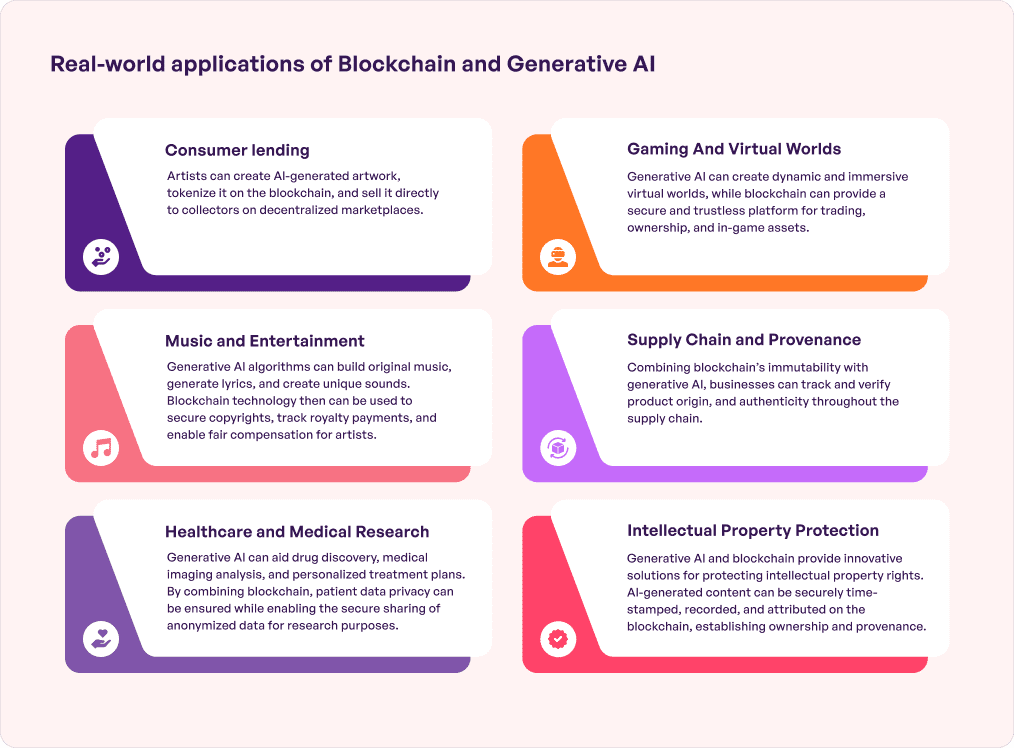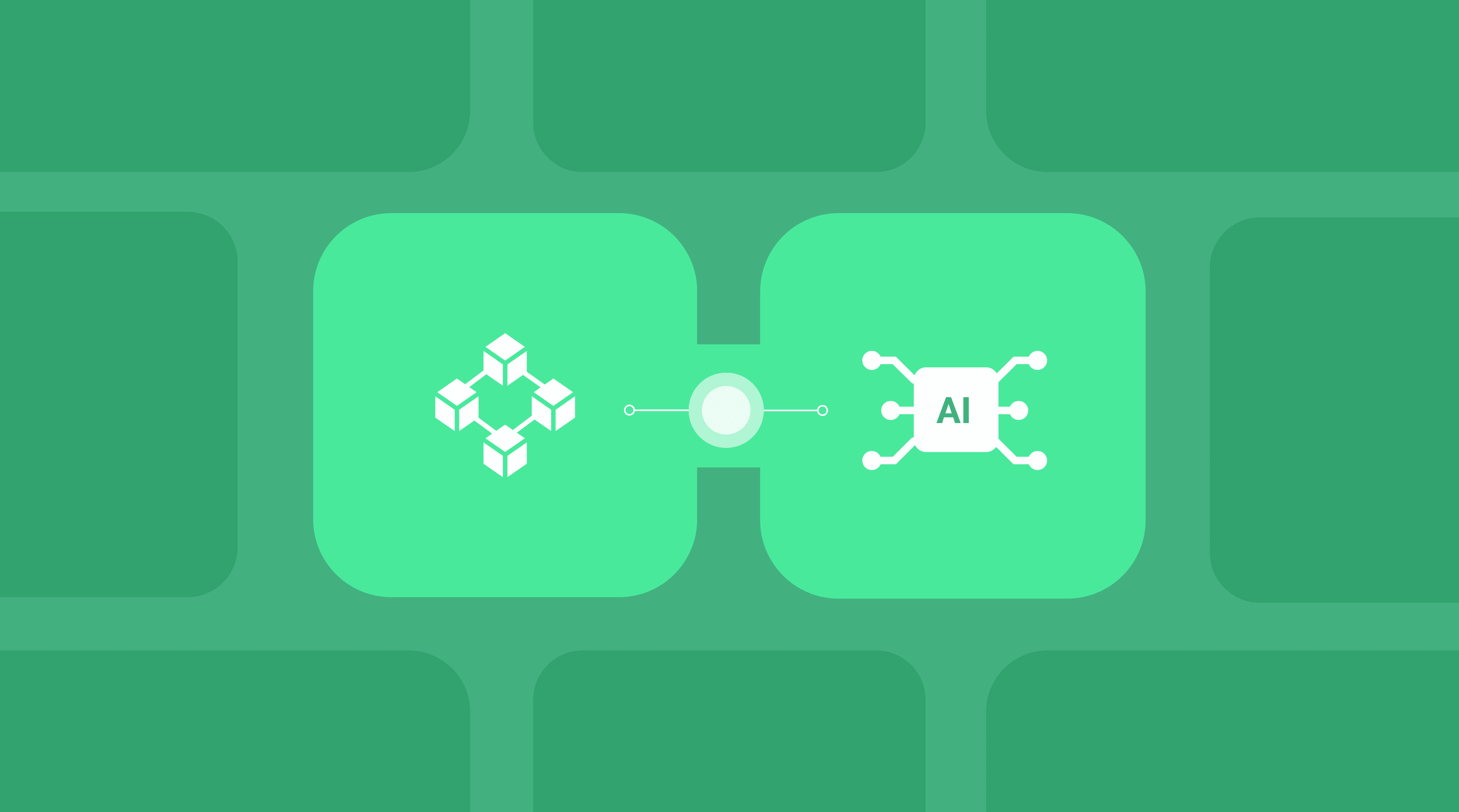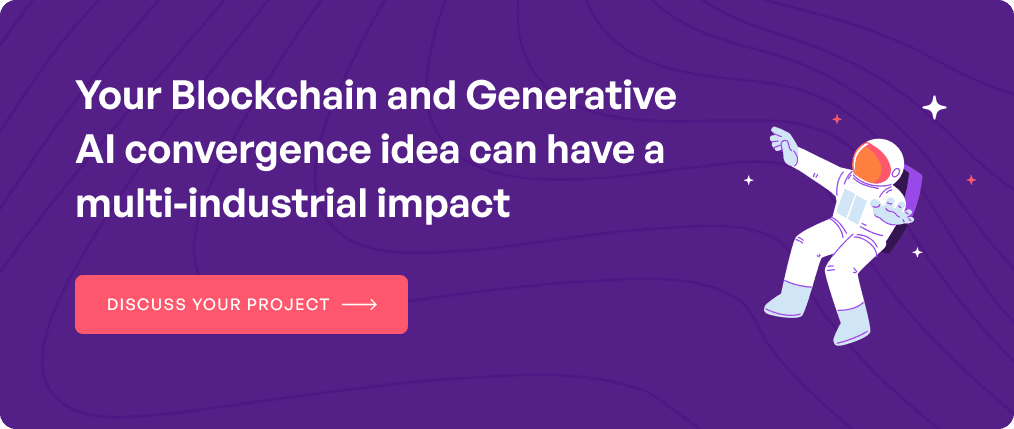Recently, we have witnessed several technologies come and stay in prominence with geolocation, machine learning, IoT, NLP, and blockchain being the ones to top the list. While immensely powerful individually, when converging, these technologies can potentially reform the world on an industry-by-industry level.
One such convergence that we will dive into today is generative AI and blockchain. Blockchain offers a secure and decentralized approach to storing and sharing information, while generative AI powers self-learning and creativity in machines and algorithms. By combining the two technologies, enhanced systems can be built that are not just secure but intelligent and adaptive.
While the merger is still being studied on the front of efficacy and profitability, tech enthusiasts have started coming up with probable use cases of their convergence. Let us look at some of them.
Table of contents
The fusion of blockchain technology with generative AI
The integration of generative AI with blockchain offers immense potential for industries to get creative, and productive with the assurance of security and accountability. Let us look into the role of blockchain in generative AI to understand the extent of their combined offerings.
Enhanced data integrity and security
Blockchain’s distributed ledger functionality offers a great solution for securing data utilized by generative AI. By storing the data in a decentralized, tamper-proof place, blockchain ensures its integrity and security. This, in turn, protects against manipulation, unauthorized access, or data compromise, making generative AI outputs a lot more accurate and reliable.
Guaranteed provenance and transparency
One of the biggest challenges that businesses aim to solve with blockchain in generative AI is guaranteeing traceability and transparency in the training models’ data. The immutable nature of blockchain enables the execution of an audit trail that would verify the origin and authenticity of data. This level of data provenance leads to better trust between stakeholders and users, allowing them to validate the quality and authenticity of data.
Powering decentralized training
By using the blockchain’s distributed functionality, training can be held across an entire network of nodes, which reduces the dependency on centralized data centers and servers. This level of decentralization improves scalability, grows resource efficiency, and promotes collaboration among participants, making the generative AI model a lot more cost-effective and accessible.
Improved efficiency and scalability
Generative AI solutions demand extensively large datasets and computational resources for training. Blockchain’s scalability prowess can easily accommodate these demands. By using its distributed computing power, the generative AI models can process large data points, expediting the inference and training tasks.
This scalability also plays a role in lowering the processing time, enhancing performance, and extending the scope of new generative AI use case development.
Better trading strategies
The volatility of cryptocurrencies needs traders to adapt quickly and make timely decisions. Generative AI and blockchain become crucial here since by analyzing the historical data and identifying the trends, and patterns, the AI model can help the traders make informed decisions. This role can further be seen to influence DeFi platforms as well where generative AI can give personalized recommendations on risk management and investments based on users’ behavior and transaction data.
Innovative tokenization
Tokenization refers to the process where real-world assets are brought to the blockchain. Generative AI solutions can help revolutionize the process through the automation of the creation and handling of tokenized assets. By using the technology, the entire tokenization of assets process can be made accurate, secure, and efficient – an advancement that directly impacts fractional ownership, allowing individuals to make investments in high-value assets such as artwork or real estate.
Secure marketplace for AI content
Combining blockchain with AI can power the creation of secure market platforms for generated content and AI models. Companies can use the combination of smart contracts and generative AI to enable automated transactions that ensure all the licenses, ownership, and usage rights are transferred securely and transparently.
The AI models can get deployed as dApps on the platforms, making it possible for the developers and users to access and use the models through a decentralized approach.
Addressal of intellectual property issues
The two ways AI and blockchain combination can be used for solving IP issues are – Controlled Usage and Unintended IP Infringements.
Creators can add IP assets to a blockchain network as non-fungible tokens with smart contracts that would establish clear permissions – attribution requirements, free usage, or compensation terms for reuse, directly in the AI models. This approach guarantees precise control over how AI interacts with proprietary data thus lowering the chance of IP violation or misuse.
A blockchain-powered IP system can also address unintentional IP infringements. Businesses can establish a system where every utilization or transaction made on AI-generated content comes with corresponding payments. This system makes sure that the creators automatically get compensation when their content is used by any machine learning model.

Looking into the role of blockchain in generative models and vice versa on a holistic level will be insufficient if you wish to understand the entirety of the convergence. To get a complete grasp on the technologies’ combination, let us look into their industry-wise impact.
Real-world use cases of blockchain integration in generative AI
The potential impact of using blockchain for generative AI or generative AI in blockchain projects is massive and far-reaching in terms of industry-wide scope. While a use case can be built for every industry where either blockchain or generative AI can be integrated, let’s have a look at the obvious participants.

Supply chain
Blockchain holds the potential to enhance traceability and visibility across the entire supply chain. Generative AI can build upon this advantage further by powering real-time decision-making for optimizing routes, cutting costs, and navigating unexpected gaps.
Smart contracts can also utilize AI predictions to place new orders in the hopes of future resource shortages. All of this can ultimately foster a proactive and agile supply chain network.
Financial solutions
Blockchain-powered DeFi solutions have already transformed traditional financial processes. When merged with generative AI, the technology can also forecast market trends, study historical transactions, and detect possible fraudulent activities.
Smart contracts can also be used to study AI-driven market insights for adapting loan interest rates in real time. It would ultimately expand flexibility within the DeFi ecosystems. Real-world applications of this combination in the fintech domain can be seen in –
- Symbiont: A fintech company using blockchain to build generative AI models that predict financial markets. Their models are being trained on massive datasets of historical financial data, which can be used for making accurate predictions compared to the traditional methods.
- R3: R3 is a fintech company building a blockchain-based platform for financial solutions. This platform can be used for training generative AI models based on large financial datasets, which can help improve these models’ accuracy.
Energy grids
Blockchain can ensure efficient and transparent energy transactions and distribution. When clubbed with a generative AI model, it can optimize the distributions of energy grids in real-time, accounting for variables such as supply, demand, and weather conditions.
This approach promises a transformative shift focused on decentralized and adaptive energy infrastructure. Moreover, the integration can foster an efficient grid with the capability of autonomously adapting to varying conditions. It, in turn, can expedite the transition towards renewable and sustainable energy solutions.
Healthcare
Blockchain technology has already proven to offer a safe platform for the healthcare domain to store patient records. It can manage a high level of data integrity and adhere to all the privacy regulations. Integrated with generative AI, healthcare experts can analyze the secure dataset to identify patterns, estimate potential health concerns, and suggest customized treatment methods.
For example, generative AI algorithms can be built to evaluate medical scans stored on the blockchain to predict a patient’s chances of having certain illnesses. Blockchain can record all the diagnoses and alterations to facilitate audits and ensure transparency. Some companies working in this direction include –
- Enlitic: A healthcare company using blockchain to build generative AI models that can find and diagnose diseases. Their models are developed on large medical images and datasets, which they use to make accurate diagnoses.
- MediLedger: A blockchain-based platform tracking and sharing medical records. The platform is being used for training generative AI models on large medical records datasets that can help improve the models’ accuracy.
Now that we have looked into the benefits of integrating blockchain in generative AI along with some real-world use cases, let us get down to some challenges that a blockchain development company can come across while in the process.
Challenges of combining generative AI and blockchain
While the convergence between blockchain and generative AI offers a lot on the innovation and applications level, there are some challenges that both generative AI development company and blockchain solutions developers face.
Effectiveness and scalability
One of the primary issues with applying generative AI in the blockchain ecosystem is guaranteeing efficiency and scalability. The resource-heavy nature of AI algorithms can put a strain on decentralized networks and slow the system’s performance. To solve this, developers are actively looking at creating lightweight AI models that run seamlessly on distributed networks. Additionally, approaches such as quantization, model pruning, and federated learning are explored to strike a balance between network efficiency and AI complexity.
Data security and privacy
Blockchain’s focus on privacy and data sovereignty builds specific challenges for generative AI. Traditional AI models tend to depend on a centralized state of data sources, which contradicts the decentralization principles and user ownership in blockchain. Striking a balance between user privacy and AI training data is critical. At Simublade, we recommend following the Federated learning approach, where AI models get trained locally on user devices, helping preserve data privacy while elevating AI capabilities.
Diversity and quality of output
Generative AI models are prone to low-quality, biased, and repetitive content. On the front of blockchain where trustlessness and diversity are crucial, making sure that the AI-generated content meets these specifications becomes essential. Researchers are working on designing inclusive training datasets and modifying model architectures to address bias. Moreover, adversarial training and reinforcement learning can better the diversity and quality of AI-generated outputs.
Attribution and intellectual property
Blockchain’s decentralized model causes concerns around the attribution and ownership of AI-powered content. Traditionally, creators used to rely on intellectual property laws to protect their work. However, with AI-backed content, finding the level of human involvement and ownership becomes extremely complex. We suggest using smart contracts to ensure transparent ownership and an automatic attribution mechanism.
Interoperability and standardization
The entire blockchain ecosystem consists of multiple protocols, blockchains, and platforms, each of them coming with its own set of architectures and rules. Ensuring interoperability between multiple generative AI systems around this wide landscape can become a challenge. Collaborative efforts made towards establishing common protocols and standards for AI models’ interaction and deployment can aid seamless integration across every Web3 platform.
Ethical and legal considerations
As AI-powered content becomes integrated into the fabric of blockchain, legal and ethical issues become prevalent. From the probable misuse of AI-powered content to unplanned consequences, a strategic framework is needed to ensure ethical and responsible AI deployment. To solve this, the entire AI community and regulatory bodies will need to collaborate and craft guidelines for the ethical use of AI in blockchain.
At Simublade, we carry expertise in building both generative AI and blockchain applications – a knowledge set that makes us your right partner for integrating the two technologies into your project. Get in touch with us to discuss your innovative business idea.
FAQs
Q. What are the benefits of integrating blockchain technology with generative AI models?
A. Several advantages come linked with the combination of blockchain in AI.
Here are the top ones: Enhanced data integrity and security, Guaranteed provenance and transparency, Powering decentralized training, Improved efficiency and scalability, Better trading strategies, Innovative tokenization, Secure marketplace for AI content, and Addressal of intellectual property issues.
Q. Is there a connection between NFTs and generative AI?
A. Several businesses are planning to connect generative AI and NFTs in a way that the content generated through AI can be converted into an NFT to be then sold in a blockchain marketplace that manages all the transactions through smart contracts.
Q. Are there any industry-specific applications of blockchain in generative AI?
A. Yes. Almost every industry can benefit from the merger of AI and blockchain. Here are some examples.
Supply chain: Blockchain holds the potential to enhance traceability and visibility across the entire supply chain. Generative AI can build upon this advantage further by powering real-time decision-making for optimizing routes, cutting costs, and navigating unexpected gaps.
Financial solutions: Blockchain-powered DeFi solutions have already transformed traditional financial processes. When merged with generative AI, the technology can also forecast market trends, study historical transactions, and detect possible fraudulent activities.
Smart contracts can also be used to study AI-driven market insights for adapting loan interest rates in real time. It would ultimately expand flexibility within the DeFi ecosystems.
Energy grids: Blockchain can ensure efficient and transparent energy transactions and distribution. When clubbed with a generative AI model, it can optimize the distributions of energy grids in real-time, accounting for variables such as supply, demand, and weather conditions.
Healthcare: Blockchain technology has already proven to offer a safe platform for the healthcare domain to store patient records. It can manage a high level of data integrity and adhere to all the privacy regulations. Integrated with generative AI, healthcare experts can analyze the secure dataset to identify patterns, estimate potential health concerns, and suggest customized treatment methods.
Q. What are some examples of successful integration of blockchain in generative AI?
A. Here are a few –
ChainGPT: The company comes with a wide range of solution offerings – An AI-based chatbot that answers every question around crypto and blockchain, a news model, a smart contracts generator, an AI NFT generator, AI trading, and security extension, etc.
Enlitic: A healthcare company using blockchain to build generative AI models that can find and diagnose diseases. Their models are developed on large medical images and datasets, which they use to make accurate diagnoses.
MediLedger: A blockchain-based platform tracking and sharing medical records. The platform is being used for training generative AI models on large medical records datasets that can help improve the models’ accuracy.




